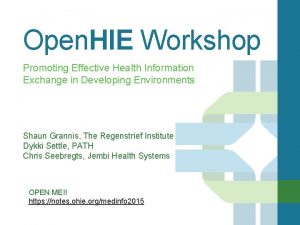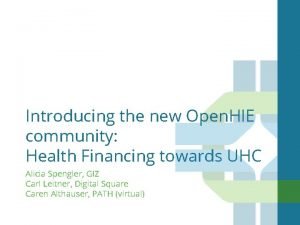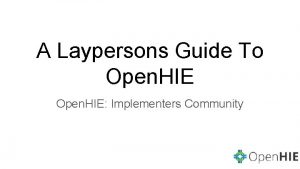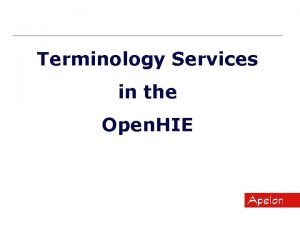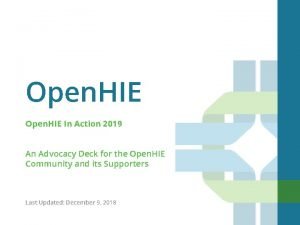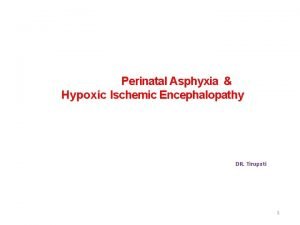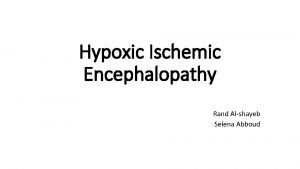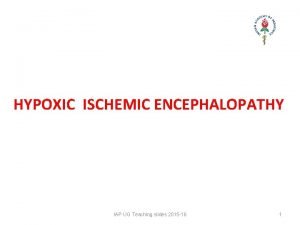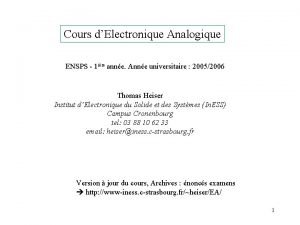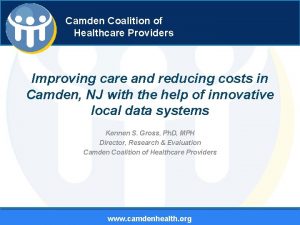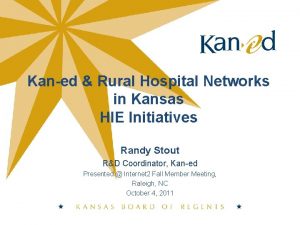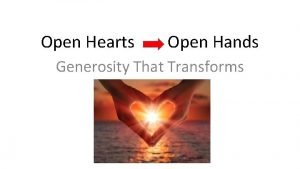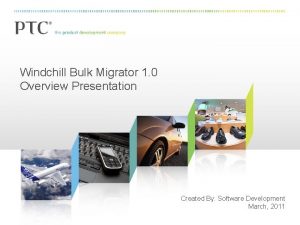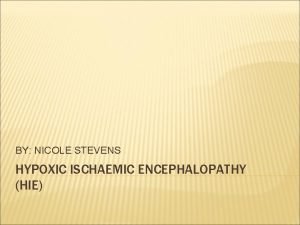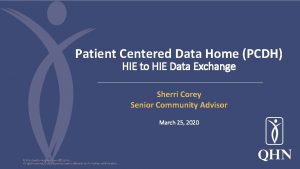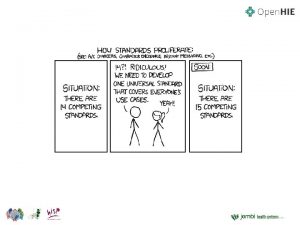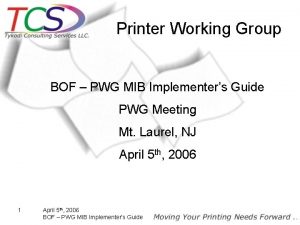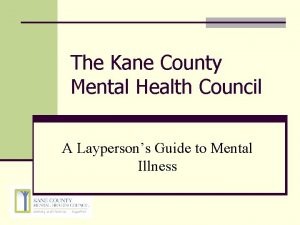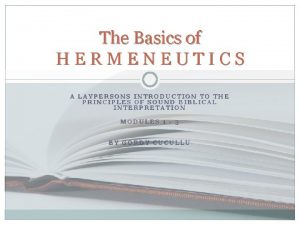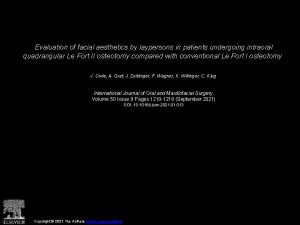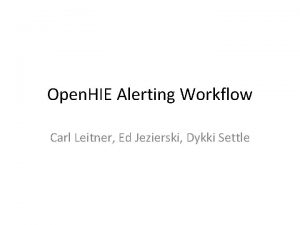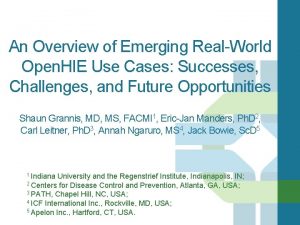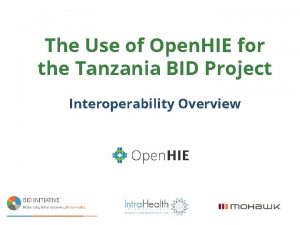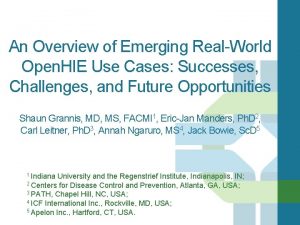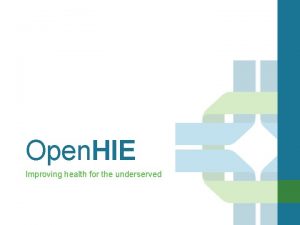A Laypersons Guide To Open HIE Implementers Community


























- Slides: 26

A Laypersons Guide To Open. HIE: Implementers Community

What is Open. HIE? Open. HIE is a Global Mission-Driven Community of Practice that is dedicated to improve the health of the underserved through open and collaborative, development and support of country driven, large scale health information sharing architectures. It is an international community working in low resource settings to: Enable large scale health information interoperability Develop and offer freely available standards-based approaches and reference technologies Support community needs through peer technical assistance communities

Community Vision and Mission Vision: We envision a world where all countries are empowered to pragmatically implement sustainable health information sharing architectures that measurably improve health outcomes. Mission: Our mission is to improve the health of the underserved through the open collaborative development and support of country driven, large scale health information sharing architectures.

More than just a community. . . The Open. HIE community supports interoperability by creating a reusable architectural framework that introduces a service oriented approach, maximally leverages health information standards, enables flexible implementation by country partners, and supports interchangeability of individual components. More than being a community Open. HIE is an architectural approach and a set of reference tools to support the objective of “Sharing Data to Improve Health Outcomes”.

What does Open. HIE do? Services are provided within a care programme (e. g. Communicable Diseases) at a point of care. . . …and information about these person-centric care services may be saved to a database… There may be multiple systems saving person-centric care information to multiple databases.

What does Open. HIE do? (. . . cont) There may be other care programmes (e. g. NCDs)… …with multiple points of service writing person-centric information to multiple databases… As these databases proliferate we need a way to tell that this information is all pertaining to the same individual. We need to be able to tell that these episodes are all chapters in single patient’s health story

What does Open. HIE do? (. . . cont) This is what Open. HIE does. It connects the data silos. Open. HIE is an architecture and a set of reference tools that can be deployed as a centrally hosted / cloud-based health information sharing service (in country or per project) that follows the golden thread of a patient’s care over time and across different care sites. Open. HIE gives care providers a way to communicate with each other as members of a care team.

How is this done? An overview of the Open. HIE Architecture and Framework

Open. HIE Architecture The fundamental basis of interoperability is in harmonizing the context with which information is collected in so that it’s broadly reusable to a much larger set of stakeholders. The Open. HIE architecture supports interoperability by creating a framework that maximally leverages health information standards, enables flexible implementation by country partners, and supports interchangeability of individual components.

Point of Service Who benefits from the health information exchange? The point of service (POS), or point of care, is a diverse group of actors that leverage the health information exchange to improve the quality of care by using higher quality and more timely data to support their activities. These systems include mobile messaging tools (SMS/IVR), electronic medical records, laboratory or stock management systems, and monitoring and evaluation tools.

Interoperability Layer Who facilitates complex interactions where multiple actors are involved? The Interoperability Layer (IL) is the component that enables easier interoperability between disparate information systems by connecting the infrastructure services and client applications together. An interoperability layer receives transactions from the point of service systems and coordinates interaction between components of the HIE and provides common core functions to simplify the interoperability between systems as well as maintaining security and audit trails of engagements with the HIE.

Terminology Service What vocabulary do we agree to use? The Terminology Services (TS) component of the Open. HIE Architecture provides a centralized source for the HIE’s standards and definitions, including terminologies, ontologies, dictionaries, code systems, and value sets. Other HIE components can use these standards and definitions to normalize clinical data and achieve consistent aggregation and reporting.

Client Registry Who received health services? The Client Registry (CR) supports the unique identification and management of patient identities. In order for the details of what specifically happens during a health service event to be understood universally, each client or patient needs to be represented in a standard way.

Shared Health Record What is a person’s cumulative health history? A Shared Health Record (SHR) enables the collection and storage of electronic health information about individual patients in a centralised repository which is capable of being shared across different healthcare settings.

Health Management Information System What is the population’s cumulative health history? The Health Management Information System (HMIS) component – stores and redistributes population level information normalized through the exchange.

Facility Registry What locations provide health services? The Facility Registry (FR) serves as the authority for maintaining the unique identities of locations where health services are provided. This is the service that manages a master facility list dataset.

Health Worker Registry Who provides health services? The Health Worker Registry (HWR) serves as the authority for maintaining the unique identities of health workers within a country.

Interoperability Layer The Interoperability Layer acts as central exchange, or service bus, which provides the following: Easy routing of messages between components Security: Authentication and Authorization Transaction Logging: Viewing the messages as they move through the exchange Auditing: Standards-based logging complying to international Transformation: Transform messages from one format to another Validation: Validate the contents of a message

Open. HIE Workflows Below are the core workflows supported by a complete Open. HIE implementation Save a new demographic record Query for a demographic record Query by ID Query by fuzzy match Update an existing demographic record Update inter-linked records Query for inter-linked records (Providers, Facilities, Organizations, Services) Save client encounter document

Open. HIE and Standards The Open. HIE, lead by the Architecture Community, framework and design works towards ensuring that each workflow is fit for purpose and standards compliant. Open. HIE is engaging with IHE in the adoption of the IHE profiles as well as proposing and developing new profiles. Open. HIE has and continues to engage in IHE events such as the connectathon to certify compliance to standards and to date is compliant with the following profiles: PIX/PDQ; CDA; XDS. b; ADX; m. ACM. . . to name a few

Open. HIE Communities Open. HIE is driven and curated by a community of communities (built around each of the framework components). The communities roles and responsibilities include: Develop and refine Open. HIE mission, vision, values and collaborative leadership Cultivate domain-specific communities of practice Define interoperability specifications and workflows Maintain forum for technology developers and implementers Identify and refine appropriate interoperability standards (working within Integrating the Healthcare Enterprise (IHE) process) Develop implementation guidance Develop and support reference technologies.

Sub Community https: //wiki. ohie. org/display/SUB/Home HIE Component Source Code Facility Registry Community Facility Registry [https: //github. com/instedd/resourcemap] Health Management Information System DHIS 2 [https: //code. launchpad. net/dhis 2] Health Worker Registry Community Health Worker Registry [https: //github. com/openhie/openinfoman] Client Registry Community Open. EMPI [https: //kenai. com/projects/openempi/sources/source-repository/show] MEDIC CR [https: //mediccr. codeplex. com/] Terminology Service Community Terminology Services [http: //apelon-dts. sourceforge. net/] Shared Health Record Community The SHR reference application is made up of a number of Open. MRS modules: http: //www. openmrs. org https: //github. com/jembi/openmrs-module-shr-xds-b-repository https: //github. com/jembi/openmrs-module-shr-cdahandler https: //github. com/jembi/openmrs-module-shr-contenthandler https: //github. com/jembi/openmrs-module-shr-odd Interoperability Layer Community The Open. HIM reference application is made up of 2 components: http: //www. openhim. org Open. HIM-core server Open. HIM admin console UI

Applying / Implementing Open. HIE is a framework and architecture with an associated set of reference tools to support each of the components. When reviewing the applicability of Open. HIE for a problem or for implementation it is important to remember that the architecture may be evolutionary. Simply put: select the components and functions that are required to support your use case. Leveraging Open. HIE allows a strong architectural pattern to expand on the initial investment to support a more integrated health system.

Some Implementations South Africa Mom. Connect - Maternal m. Health City Of Cape Town Aggregate Data Exchange Lesotho DHIS 2 Interoperability - aggregate data exchange Rwanda Health Information Exchange Project - Maternal Care Tanzania

Getting involved If you would like to discuss a project or join a community, get in touch with us. The Open. HIE community is excited to assist implementations of all sizes to develop the resources and skills to manage and connect their health systems. We listen, we build local capacity, and we help deliver the systems local experts need. But we can’t do it alone. We need your help to understand local requirements, provide solutions, and advocate for our strategy. Introduce yourself and get started today, ask a question, or jump straight into a sub-community. Open. HIE Community Google Group [https: //groups. google. com/forum/#!forum/openhie-announcements] Direct enquires: info@ohie. org Open. HIE Subcommunities: https: //wiki. ohie. org/display/SUB/Home Open. HIE Mailing Lists: https: //wiki. ohie. org/display/resources/Mailing+Lists Websites and Wiki

END Websites and Wiki http: //www. ohie. org | http: //wiki. ohie. org
 Open hie
Open hie Open hie
Open hie Open hie
Open hie Terminology services
Terminology services Open hie
Open hie Open innovation open science open to the world
Open innovation open science open to the world Hie
Hie Simone hie
Simone hie Roshini jayasankar
Roshini jayasankar Sarnat score
Sarnat score Sarnat staging
Sarnat staging Hie transistor
Hie transistor Camden hie
Camden hie Intranet kfmc
Intranet kfmc Akaims
Akaims Simone hié
Simone hié Chapter 3 section 1: community ecology answer key
Chapter 3 section 1: community ecology answer key Community action cycle for community mobilization
Community action cycle for community mobilization Chesterton community college
Chesterton community college Plc timer symbol
Plc timer symbol Open hearts open hands
Open hearts open hands Writing informative essays
Writing informative essays World history and geography final exam study guide
World history and geography final exam study guide Words their way spelling test template
Words their way spelling test template Sperry
Sperry Windermere high school guidance counselors
Windermere high school guidance counselors Windchill bulk migrator installation and usage guide
Windchill bulk migrator installation and usage guide
